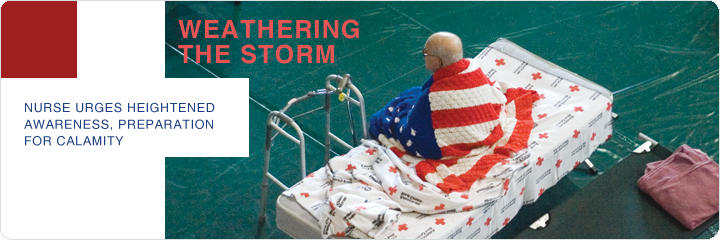
She has seen houses ripped from their foundations, elderly people evacuated from their homes without their medications and rescue dogs whose feet were burned in the rubble of the World Trade Center.
Laura Terriquez-Kasey comes by her understanding of disasters the hard way — through working at New York City hospitals, serving in the U.S. Army and reserves, and spending more than six years as a member of a disaster medical assistance team, or DMAT, a specialized group mobilized by the Department of Homeland Security in catastrophic emergencies.
A clinical lecturer at Binghamton University’s Decker School of Nursing with 35 years of nursing experience, Terriquez-Kasey thinks it’s time to raise and respond, at local, regional and national levels, to the same pressing disaster-related questions she routinely poses to her students.
“What do we do about it?“ “How could this be prevented?“ “What can we do better?“
As she organized the annual disaster drill on Binghamton’s 887-acre campus last spring, Terriquez-Kasey called upon her experience and devised a hauntingly prescient scenario: several weeks of rain would flood Floral Park and Lourdes Hospital in Binghamton. The University’s Events Center would be needed as a shelter for special-needs patients and the elderly. As the drill began, her closing instructions to the team were plain and — as unfolding events would prove — prophetic: “It is critical we plan for such an event as it is perfectly plausible this could occur in this community.“
Just weeks later, the drill proved a dress rehearsal, as torrential rains caused a precipitous rise in the Susquehanna, Delaware and Chenango rivers, breaching 500-year floodplains, closing an area hospital, forcing the evacuation of tens of thousands and sending nearly 2,000 evacuees from throughout Greater Binghamton to a Red Cross shelter established at the University’s Events Center.
Several weeks later, as Terriquez-Kasey sat in her office amid books such as Toxic Terror, The New Killer Diseases and Confronting Catastrophe, and reviewed lecture notes punctuated with stark pictures of the disasters she has seen, it was clear that she took no personal satisfaction from being dead-on accurate about the scenario she selected for last May’s disaster drill. But something else was also clear: She knows that if there is a silver lining to be found in the deluge that caused catastrophic flooding of the region, or in events ranging from Hurricane Katrina to the Sept. 11 terrorist attacks, it is in the likelihood that such events will sharpen our focus on disaster management.
“We as a nation need to change the way we think about preparation,“ she said. “We have that syndrome: ’It’s not going to happen here.’“
She added: “I see disaster education as a mission because many lives could be saved if we could better educate people. The community itself has to be educated. I think we need to get our heads out of the sand regarding safety issues. People don’t have a healthy respect for nature — and we should.“
Never content to just talk the talk, Terriquez-Kasey advocated, even early in her career, for more disaster education for the Army nurse corps, where she ran courses and conferences while in the military. When she worked at Mary Imogene Bassett Hospital in Cooperstown, N.Y., in the late 1990s, she put together central New York’s first hazardous materials response team. And now, at Binghamton, she continues to expand on and enhance the value of her personal DMAT experiences by sharing them with interested audiences.
That sometimes means presenting information about the disasters she has seen to government and nursing groups. It also often means tying her real-world experiences into the content of the two online graduate-level courses she teaches. One of those courses focuses on disaster preparation for community and public health nurses; the other on emerging threats, with a focus on such biohazards as flu epidemics and plague.
page 1 | page 2